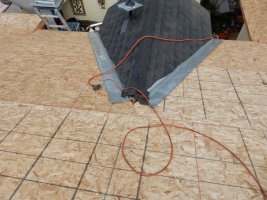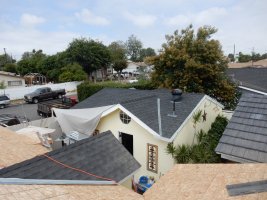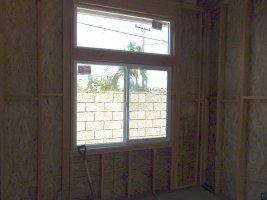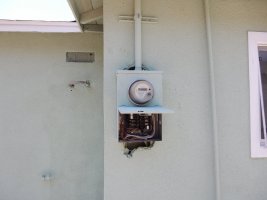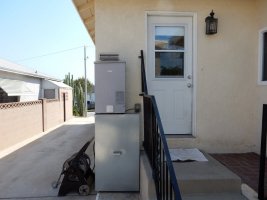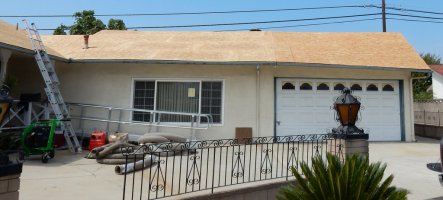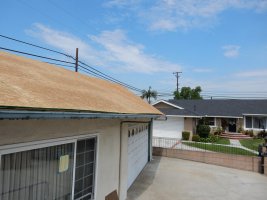-
Welcome to The Building Code Forum
Your premier resource for building code knowledge.
This forum remains free to the public thanks to the generous support of our Sawhorse Members and Corporate Sponsors. Their contributions help keep this community thriving and accessible.
Want enhanced access to expert discussions and exclusive features? Learn more about the benefits here.
Ready to upgrade? Log in and upgrade now.
You are using an out of date browser. It may not display this or other websites correctly.
You should upgrade or use an alternative browser.
You should upgrade or use an alternative browser.
An average day
- Thread starter ICE
- Start date
Today was the third trip and not much progress has been made. The last time there was supposed to be a pressure test....the gauge read zero PSI. Today there was another attempt at a pressure test. The gauge reads maxed out but there is no pressure in the pipe. I always release a bit of air to see if the gauge works. As you can see they don't know how to treat CSST.

I called the contractor. A receptionist transfered me to "one of the Installation Managers". That guy did not know what CSST is. I told him that the CSST must be removed and hard pipe installed. He said that I can't do that if they are able to install the CSST correctly. So I scared the homeowner with the truth....she will demand that the CSST be removed.


I called the contractor. A receptionist transfered me to "one of the Installation Managers". That guy did not know what CSST is. I told him that the CSST must be removed and hard pipe installed. He said that I can't do that if they are able to install the CSST correctly. So I scared the homeowner with the truth....she will demand that the CSST be removed.

Last edited:
conarb
REGISTERED
But look at all the trees they saved. I read an article once by the eminent building scientist Joe Lstiburek that recommended some thing like that, I decided to check our Green Code and see if his recommendations made it in but they didn't:
While I'm in the Green Code I'm posting other things a good Tiger would check for:
I might point out that much of these requirements are "Voluntary Measures", at least in this cycle; however you better start checking for it because it may be a portion of Green Code compliance.
2013 California Gren Code said:SECTION A5.404
EFFICIENT FRAMING TECHNIQUES
AS.404.1 Wood framing. Employ advanced wood framing
techniques or OVE, as recommended by the U.S. Department
of Energy's Office of Building Technology, State and Community
Programs and as permitted by the enforcing agency.
AS.404.1.1 Structural or fire-resistance integrity. The
OVE selected shall not conflict with structural framing
methods or fire-rated assemblies required by the California
Building Code.
AS.404.1.2 Framing specifications. Advanced framing
techniques include the following:
1. Building design using 2-foot modules;
2. Spacing wall studs up to 24 inches on center;
3. Spacing floor and roof framing members up to 24
inches on center;
4. Using 2-stud comer framing and drywall clips or
scrap lumber for drywall backing;
5. Eliminating solid headers in non-load-bearing walls;
6. Using in-line framing, aligning floor, wall and roof
framing members vertically for direct transfer of
loads; and
7. Using single lumber headers and top plates where
appropriate.
Note: Additional information can be obtained from the
U.S. DOE Energy Efficiency and Renewable Energy
(EERE) website.
While I'm in the Green Code I'm posting other things a good Tiger would check for:
2013 California Green Code said:AS.40S.2.2 Rapidly renewable materials. Use materials
made from plants harvested within a ten-year cycle for at
least 2.5 percent of total materials value, based on estimated
cost.
AS.40S.3 Reused materials. Use salvaged, refurbished, refinished
or reused materials for a minimum of 5 percent of the
total value, based on estimated cost of materials on the project.
Provide documentation as to the respective values.
Note: Sources of some reused materials can be found at
CalRecycle. See also Appendix A5, Division A5.I, Section
A5.105.1 for on-site materials reuse.
I might point out that much of these requirements are "Voluntary Measures", at least in this cycle; however you better start checking for it because it may be a portion of Green Code compliance.
Last edited:
TheCommish
SAWHORSE
I like it, the is no reason to waste all the wood we put in to frames, split jacks carry the load just fine, the small opening (Less the 8 feet) with double jacks, king stud and a jack under the sill is a waste. BTY why do they put double sills, the is no need for that either there is no need for piles of studs at intersections, move the window to take advantage of the lay out, leave the extra stud out gives better insulation coverage
This is an email that I received after I left a notice at the front door regarding a plumbing permit for a water heater that is about to expire.
"You left a notice at the above address regarding a plumbing permit that's about to expire. If it's related to the A/C Installation I did there more than 5 years ago, you inspected this installation. You might remember I had the pressure gauge in the hole where the old floor furnace was and I pressurized with 60 psi of nitrogen (I told you it hadn't moved in 2 days). You bled down to 15 psi and passed it. I remember telling you that LIQUID nitrogen at 70 degrees produces 10,000 psi of pressure. Do you remember this? Does this resolve the open permit?"
"You left a notice at the above address regarding a plumbing permit that's about to expire. If it's related to the A/C Installation I did there more than 5 years ago, you inspected this installation. You might remember I had the pressure gauge in the hole where the old floor furnace was and I pressurized with 60 psi of nitrogen (I told you it hadn't moved in 2 days). You bled down to 15 psi and passed it. I remember telling you that LIQUID nitrogen at 70 degrees produces 10,000 psi of pressure. Do you remember this? Does this resolve the open permit?"
Paul Sweet
SAWHORSE
My main concern with the trimmers in #2047 is all the cross-grain lumber will shrink more than the full stud next to them, so the full studs will end up taking all the load. That's OK for the narrow windows, but could be a problem on the wider windows if there is a floor above.
There's been an anonymous complaint about "a carport built to the property line without a permit".
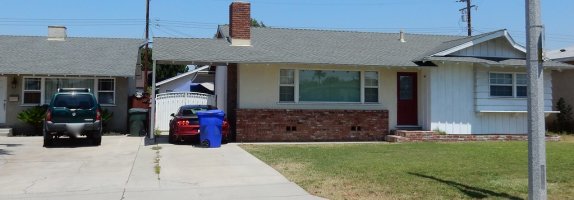
There is a permit from the dawn of time for a house and no separate permit for a carport. It appears as though the carport came with the house.
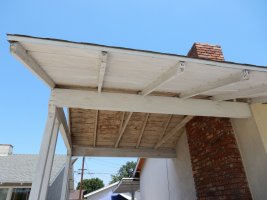
Now if the person that complained knew how to play the game they would have said, "Excuse me but I see something. This guy built a patio cover without a permit"
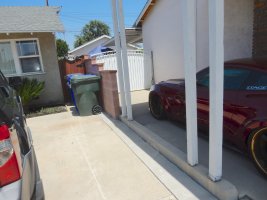
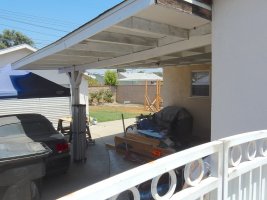

There is a permit from the dawn of time for a house and no separate permit for a carport. It appears as though the carport came with the house.

Now if the person that complained knew how to play the game they would have said, "Excuse me but I see something. This guy built a patio cover without a permit"


Last edited:
steveray
SAWHORSE
ICE...The first pic in 2045, is it mainly the nailing about 2" down from the top of the shingle that is the issue or is there something else I am not seeing right now?
The first picture shows the paper under the valley flashing....the next picture shows that they forgot it.ICE...The first pic in 2045, is it mainly the nailing about 2" down from the top of the shingle that is the issue or is there something else I am not seeing right now?
tmurray
SAWHORSE
wow...just...wow
steveray
SAWHORSE
The paper under is not required....no? And the parallel runs are over.....The first picture shows the paper under the valley flashing....the next picture shows that they forgot it.
R905.2.8.2 Valleys. Valley linings shall be installed in accordance with the manufacturer's installation instructions before applying shingles. Valley linings of the following types shall be permitted:
1. For open valleys (valley lining exposed) lined with metal, the valley lining shall be at least 24 inches (610 mm) wide and of any of the corrosion-resistant metals in Table R905.2.8.2.
6-23-16
Good Afternoon Mr. ######,
I am the homeowner at 9484 ******** Avenue in #######. You recently inspected the roof on June 20. You wrote that singles may not be put on the house because the pitch is too small (1.5 inches).
I am in the middle of a refi with this house and want/need to get the roof done by the appraisal date (July 1). Therefore, I had some questions.
1) Is there an adjustment I can make to the roof that would allow me to use shingles? I see numerous homes in my neighborhood with the same roof as me. They all have shingles so I am wondering what changes were made to pass inspection.
2) Rolled roofing is, well, very unattractive and I fear it would lower the value or appeal of this home should I choose to sell in the future. Could extra layers of felt be used before putting on shingles?
Respectfully,
******* *******
6-24-16
Mr. ********,
Unfortunately, shingles are not permitted below a 2” in 12” pitch. The fact that there are dwellings with a low pitch that have shingles may be due to a lack of a permit or a mistake made by all parties involved.
Rolled roofing is not the only option as a rock roof would be allowed.
##### #######
6-24-16
Thank you for your response Mr. ######.
With all due respect, all of the homes in the area are shingled. Having a rock roof would make my house stick out like a sore thumb. It is not aesthetically pleasing. Furthermore, it releases harmful fumes when being put on, and, having a son with asthma who is sensitive to air quality, I have concerns about that. When I bought the house it had a new roof that was shingled. All I want to do is the same thing as all of the homes in my neighborhood. If every other home is allowed to have shingles, including mine before the tear-off, even with a pitch that is 1/2 inch too low, I really don't understand why this is a problem if I do that. I understand your point about building codes, but if I am being held to that standard then shouldn't everyone else? Also, it escaped the city's attention that so many homes were shingled and shouldn't have been? I am trying to do right here by pulling permits and doing everything out in the open, yet I am now on my 10th day without a roof and all of the material is sitting on top of my house. That just isn't right.
Respectfully,
******* *******
6-29-16
Nothing to report.
Good Afternoon Mr. ######,
I am the homeowner at 9484 ******** Avenue in #######. You recently inspected the roof on June 20. You wrote that singles may not be put on the house because the pitch is too small (1.5 inches).
I am in the middle of a refi with this house and want/need to get the roof done by the appraisal date (July 1). Therefore, I had some questions.
1) Is there an adjustment I can make to the roof that would allow me to use shingles? I see numerous homes in my neighborhood with the same roof as me. They all have shingles so I am wondering what changes were made to pass inspection.
2) Rolled roofing is, well, very unattractive and I fear it would lower the value or appeal of this home should I choose to sell in the future. Could extra layers of felt be used before putting on shingles?
Respectfully,
******* *******
6-24-16
Mr. ********,
Unfortunately, shingles are not permitted below a 2” in 12” pitch. The fact that there are dwellings with a low pitch that have shingles may be due to a lack of a permit or a mistake made by all parties involved.
Rolled roofing is not the only option as a rock roof would be allowed.
##### #######
6-24-16
Thank you for your response Mr. ######.
With all due respect, all of the homes in the area are shingled. Having a rock roof would make my house stick out like a sore thumb. It is not aesthetically pleasing. Furthermore, it releases harmful fumes when being put on, and, having a son with asthma who is sensitive to air quality, I have concerns about that. When I bought the house it had a new roof that was shingled. All I want to do is the same thing as all of the homes in my neighborhood. If every other home is allowed to have shingles, including mine before the tear-off, even with a pitch that is 1/2 inch too low, I really don't understand why this is a problem if I do that. I understand your point about building codes, but if I am being held to that standard then shouldn't everyone else? Also, it escaped the city's attention that so many homes were shingled and shouldn't have been? I am trying to do right here by pulling permits and doing everything out in the open, yet I am now on my 10th day without a roof and all of the material is sitting on top of my house. That just isn't right.
Respectfully,
******* *******
6-29-16
Nothing to report.
steveray
SAWHORSE
Amazing how willing people are to do it wrong....
tmurray
SAWHORSE
Rip some 2Xs on an angle. throw some plywood sheathing on top. Congratulations, you can now use shingles. Don't want to do that? Well, don't use shingles then. I often wonder how hard life is for stupid people. It must be horrible.
mtlogcabin
SAWHORSE
Most banks will not accept rolled roofing as an approved material for financing purposes
Instead of installing 2 layers of 15# felt as an under-layment for asphalt shingles as required by the code the homeowner could use self adhering ice and water shield as an under-layment for the entire roof prior to installing shingles. Wind driven rain is the problem with low slope roofs and asphalt shingles and the fact there is no warranty on a roof with less than a 2/12 pitch
Instead of installing 2 layers of 15# felt as an under-layment for asphalt shingles as required by the code the homeowner could use self adhering ice and water shield as an under-layment for the entire roof prior to installing shingles. Wind driven rain is the problem with low slope roofs and asphalt shingles and the fact there is no warranty on a roof with less than a 2/12 pitch
my250r11
SAWHORSE
Could use a metal roof, but that costs more but many poeple think it looks nicer and less maintainance.
conarb
REGISTERED
What I don't understand about the inspector's suggestions is why he didn't suggest something we've done forever, usually on 4:12 pitch homes that have porches where the pitch flattens out. namely install roll roofing and apply the shingles on top of the roll roofing. It is mandatory now to install a light-colored roll roofing under tile roofing of all pitches, apparently an energy code thingy to reflect heat up to save the planet.
What I don't understand about the inspector's suggestions is why he didn't suggest something we've done forever, usually on 4:12 pitch homes that have porches where the pitch flattens out. namely install roll roofing and apply the shingles on top of the roll roofing. It is mandatory now to install a light-colored roll roofing under tile roofing of all pitches, apparently an energy code thingy to reflect heat up to save the planet.
Quoting Tommy, the oldest Henderson boy, "here's the thing about that". We're not dealing with a porch.
By the way, when shingles are applied on a pitch below 2" the warranty is void. If shingles are applied over roll roofing, two warranties are void.
conarb
REGISTERED
I never pay any attention to warranties, getting a manufacturer of construction products to honor a warranty costs more than just paying to fix it yourself. An example, most caulking has a warranty of 50 years written on each tube, read the mall print, you have to provide a copy of the receipt for each tube, you also have to provide the actual computer code cut from each tube, if you succeed they limit their liability to the cost of each tub and specifically reject any consequential damages, so you get $4.95 from the manufacturer and can have millions of dollars in mold damages..Quoting Tommy, the oldest Henderson boy, "here's the thing about that". We're not dealing with a porch.
By the way, when shingles are applied on a pitch below 2" the warranty is void. If shingles are applied over roll roofing, two warranties are void.
Another example, I was doing ADA work on a large Catholic church, other things came up like leaks in copper flashings, looking at them it became obvious that large areas of the clay tile were deteriorating badly, the roof was within the 20 year warranty, I contacted the original contractors and they had no documentation of the purchase of the tile 20 years earlier, each tile had the name of the manufacturer stamped into the tile, the manufacturer declined to honor the warranty based on the lack of documentation, unbelievably the architect for the archdiocese wanted to reroof the church with the same tile even though they had just declined the warranty so they paid all over again (the architect determined that the failure was due to some bad clay from a bad pit) .
Another example, I never put caulking behind window fins even though flashing and window manufacturers all require it, the reason is my experience has shown that caulking lasts an average of 7 years on the weather side in this area (longer on other elevations), I water test all windows before any siding or stucco goes on (but after the lath), caulking will temporarily seal the window, if there are any leaks I want to know now, not 9 years later, plus good contractors never use caulking (I started in this business before caulking was invented), so none of my buildings have warrantied windows.
I don't think that it's called ADA work when it takes place at a church.
conarb
REGISTERED
It was, it was voluntary, but there is another reason, if a church rents out space to others it is considered a public accommodation and must be ADA compliant, I can't rent any car and smoke my cigars in it because California has ruled that car rentals are public accommodations, my voting place changed about 5 years ago to a local Episcopal church, a voting place certainty has to be ADA compliant. BTW, permit fees were double normal residential permit fees, I asked why and the CBO told me churches are considered commercial enterprises and pay the higher commercial permit fees.I don't think that it's called ADA work when it takes place at a church.


